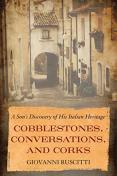BKMT READING GUIDES
Cobblestones, Conversations, and Corks: A Son's Discovery of His Italian Heritage
by Giovanni Ruscitti
Paperback : 224 pages
0 club reading this now
0 members have read this book
Introduction
“Giovanni Ruscitti has written a wonderful book of special relevance for all North and South Americans whose ancestors have migrated from Asia, Europe, and Africa. His journey to the land of his forefathers is so meaningful not only because of the discovery of what connects us ‘Americanos’ to the rest of the world but also the journey within. A trip in which we all feel recognized. Bravo maestro!”—Hernando de Soto, finalist for Nobel Prize in Economic Sciences, and author of Mystery of Capital
Cobblestones, Conversations, and Corks is a passionate and deeply moving story about a father-son relationship; a culture rooted in family, food and wine; and an ancestral small town in Central Italy that was left behind after World War II.
On November 11, 1943, the Nazis invaded Cansano, forcing its two thousand inhabitants to make a tough decision—fight and be killed or sent to a POW camp, stay behind as servants to the Nazis, or move into the unforgiving mountains of Abruzzo while the Nazis used their village as a home base. Giovanni Ruscitti’s family chose the latter and spent the next few months living in horrendous winter conditions in the rugged mountains. When the war ended, they returned to a village so ravaged by the Nazis that, today, the town has less than two hundred citizens and remains in a dilapidated state.
In this memoir, Ruscitti visits Cansano for the first time with his family, including parents Emiliano and Maria. As he walks Cansano’s cobblestones, his father’s stories and life are illuminated by the town piazza, the steep valley, and the surrounding mountains. He relives the tales of his parents’ struggles during World War II, their extreme post-war misery and poverty, their budding romance after, and their decision to immigrate to the US in search of the American Dream.
Ruscitti’s adventure is not just an exploration of his homeland but reveals what family, culture, wisdom, and love really means. And what our heritage really tells us about who we are.
Editorial Review
No Editorial Review Currently AvailableExcerpt
Chapter 13, The Nazi Invasionp. 62-65
On the morning of October 17, 1943, the Nazis invaded Cansano. With a net of troops surrounding the town, the soldiers entered the piazza and began firing randomly in the streets. On a loudspeaker, which could be heard through the entire town, they demanded that all men ages sixteen to sixty report to the post office building; if they didn’t, their home would be destroyed. No one turned themselves in and the Nazis carried out their promise. Men, fearing capture, tried to flee into the valley and the mountains but fell right into the Nazis’ trap. Women and children hid in town and some escaped into the valley. ...
Discussion Questions
Through the author’s story, how important do you think it is to visit one’s ancestral homeland? Or are family stories enough to make an impression?How did food and wine teach the author about his culture?
Through the author’s visits, what is something new that he learned about himself, his family, or the countries of Italy and the United States?
What difficulties did the author and his family face when assimilating in American culture?
How does the author’s family’s story reflect the American Dream? How is it different than other immigrant stories?
Book Club Recommendations
Recommended to book clubs by 0 of 0 members.
Book Club HQ to over 90,000+ book clubs and ready to welcome yours.
Get free weekly updates on top club picks, book giveaways, author events and more








